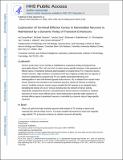Expression of Terminal Effector Genes in Mammalian Neurons Is Maintained by a Dynamic Relay of Transient Enhancers
Author(s)
Rhee, Ho Sung; Closser, Michael; Guo, Yuchun; Bashkirova, Elizaveta V.; Tan, G. Christopher; Gifford, David K.; Wichterle, Hynek; ... Show more Show less
DownloadAccepted version (2.814Mb)
Terms of use
Metadata
Show full item recordAbstract
© 2016 Elsevier Inc. Generic spinal motor neuron identity is established by cooperative binding of programming transcription factors (TFs), Isl1 and Lhx3, to motor-neuron-specific enhancers. How expression of effector genes is maintained following downregulation of programming TFs in maturing neurons remains unknown. High-resolution exonuclease (ChIP-exo) mapping revealed that the majority of enhancers established by programming TFs are rapidly deactivated following Lhx3 downregulation in stem-cell-derived hypaxial motor neurons. Isl1 is released from nascent motor neuron enhancers and recruited to new enhancers bound by clusters of Onecut1 in maturing neurons. Synthetic enhancer reporter assays revealed that Isl1 operates as an integrator factor, translating the density of Lhx3 or Onecut1 binding sites into transient enhancer activity. Importantly, independent Isl1/Lhx3- and Isl1/Onecut1-bound enhancers contribute to sustained expression of motor neuron effector genes, demonstrating that outwardly stable expression of terminal effector genes in postmitotic neurons is controlled by a dynamic relay of stage-specific enhancers.
Date issued
2016-12Department
Massachusetts Institute of Technology. Computer Science and Artificial Intelligence LaboratoryJournal
Neuron
Publisher
Elsevier BV
Citation
Rhee, H. S., et al. "Expression of Terminal Effector Genes in Mammalian Neurons Is Maintained by a Dynamic Relay of Transient Enhancers." Neuron 92 6 (2016): 1252-65.
Version: Author's final manuscript
ISSN
0896-6273